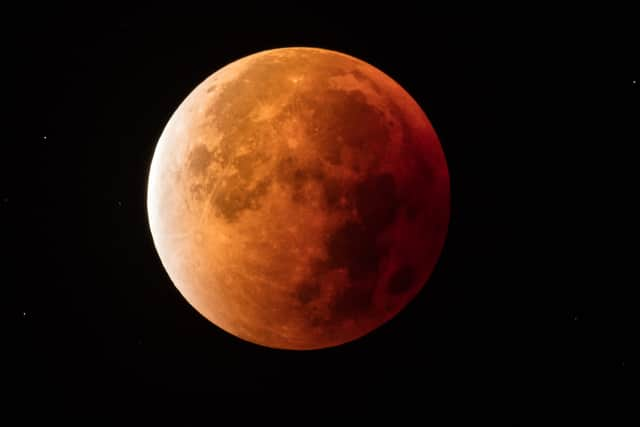Lunar eclipse: when is the next total or penumbral moon eclipse in the UK 2024 - what is a lunar eclipse?
and live on Freeview channel 276
Solar eclipses may provide the most spectacular celestial phenomena we Earthlings get to experience, but lunar eclipses certainly come in at a close second.
A lunar eclipse occurs when the Earth comes directly between the Sun and the orbit of the Moon, causing the Earth's shadow to be cast on the Moon. This phenomenon happens only during a full moon when the three celestial bodies are aligned in a straight line in space.
Advertisement
Hide AdAdvertisement
Hide AdWhen this happens, the Moon can take on a reddish hue - often referred to as a "blood moon" - due to Earth's atmosphere scattering sunlight and allowing only the longer-wavelength red hues to reach the Moon.
So when exactly will the next lunar eclipse take place, and - perhaps most importantly - will it be visible from the UK? Here is everything you need to know.
What is a lunar eclipse?
There are three types of lunar eclipses. Total lunar eclipses occur when the Earth's umbra (the central and darkest part of its shadow) completely covers the Moon. It's during these types of eclipse that we get a "blood moon", when the Moon appears to take on a reddish tint.
In a partial lunar eclipse, only a portion of the Moon enters the Earth's umbra, resulting in a partial darkening of the lunar surface A penumbral lunar eclipse is more subtle, and occurs when the Moon passes through the Earth's penumbra, the outer and lighter part of its shadow.
Advertisement
Hide AdAdvertisement
Hide AdDuring a penumbral lunar eclipse, the darkening of the Moon is often challenging to observe with the naked eye.
Lunar eclipses are safe to observe without any special eye protection, unlike solar eclipses. They can be observed from any location on the night side of the Earth where the Moon is visible during the eclipse.


Are there any lunar eclipses in 2024?
Lunar eclipses are not actually particularly rare events, and on average, there are at least two to four each year. However, not all of them are visible from any given location on Earth, and the visibility depends on the observer's geographical location.
Lunar eclipses can only occur during a full moon, when the Moon is on the opposite side of the Earth from the Sun. Even then, a lunar eclipse does not happen every full moon because the orbit of the Moon is inclined relative to the plane of Earth's orbit around the Sun.
Advertisement
Hide AdAdvertisement
Hide AdThis inclination means that the Earth's shadow doesn't always fall on the Moon during every full moon.
In 2024, there will be two lunar eclipses. A penumbral lunar eclipse on Monday 25 March, and a partial lunar eclipse on Wednesday 18 September.
Will they be visible from the UK?
As mentioned, not all lunar eclipses are observable from every point on Earth, and visibility is dependent upon the observer's geographical location. So will the two lunar eclipses of 2024 be visible from the UK?
Unfortunately, the penumbral lunar eclipse taking place on 25 March won't be visible from Britain. Instead, it will be fully visible from most of the Americas, and will be seen rising over Australia and eastern Asia, and setting over the farthest western parts of Africa and Europe.
Advertisement
Hide AdAdvertisement
Hide AdHowever, the partial lunar eclipse of 18 September will be more readily viewable from the UK. It will be completely visible over western parts of Africa and Europe, South and eastern North America, and will be seen rising over the rest of North America, and setting over the rest of Africa and Europe.
This eclipse also coincides with the first supermoon of the year, meaning the full moon on that day will appear brighter and larger than average in the night sky.
When are the full moons of 2024?
The full list of exact dates for the full moons of 2024 - and their 'traditional' names - is below, complete with which ones are supermoons.
- Wolf Moon on Thursday 25 January
- Snow Moon on Saturday 24 February
- Worm Moon on Monday 25 March
- Pink Moon on Wednesday 24 April
- Flower Moon on Thursday 23 May
- Strawberry Moon on Saturday 22 June
- Buck Moon on Sunday 21 July
- Sturgeon Moon on Monday 19 August
- Harvest Moon on Wednesday 18 September (SUPERMOON)
- Hunter’s Moon Thursday 17 October (SUPERMOON)
- Frost Moon on Friday 15 November
- Cold Moon on Sunday 15 December
Comment Guidelines
National World encourages reader discussion on our stories. User feedback, insights and back-and-forth exchanges add a rich layer of context to reporting. Please review our Community Guidelines before commenting.
